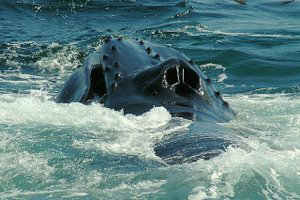Humpback whales employ a wide variety of foraging methods, including cooperative feeding on prey enclosed in "nets" of exhaled air bubbles.
Photo Credit: Geoffrey A. Hammerson
Megaptera novaeangliae
Common Name: humpback whale
Animal Guild: Mammal
Class > Order > Family: Mammalia > Cetacea > Balaenopteridae
